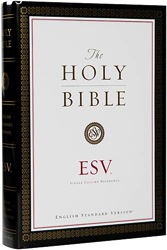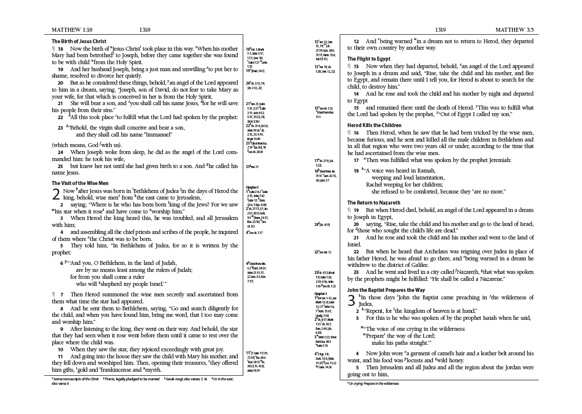Review: ESV Single Column Reference Bible
05/09/2007 08:18 Filed in: Faith & Reason

The SCR is one of a number of new editions of the ESV from Crossway that incorporates a text with minor updating from the original 2001 edition. The first text to incorporate the updated text was the ESV Reverse Interlinear released late in 2006. An updated text including the Old Testament was released earlier this year. Disappointingly, the publishers (or perhaps the translation committee) have chosen not to release a list of changes between the two editions. Of course that doesn't stop one from hunting or the changes the old fashioned way, simply by comparing texts. Last year, I released a short list of changes in the New Testament I had discovered between the 2001 and 2006 editions. As a student of translations and translation history, this kind of issue interests me very much. In the upcoming days or weeks, look for a post with any additional changes in the ESV OT that I may find.
Frequent visitors to This Lamp know that I have a fondness for wide-margin Bibles. I have a NASB wide-margin Bible in which I still add notes and reflections even to this day. And it used to be helpful as a teaching Bible--having my notes so handy--until I became convicted that the NASB was no longer the best Bible from which to teach. Nevertheless, I recommend to my own students and to friends and church members who ask that they buy a wide-margin Bible so that they might truly interact with God's Word in a physical way, a literally tangible way.
Unfortunately, of all the major 21st century Bible versions (ESV, The Message, NET, NLTse, HCSB, TNIV), only the ESV offers a truly usable wide-margin Bible--and they actually offer more than one. In addition to the SCR discussed here, Crossway also offers an edition called "The Wide Margin Refefence Bible," as well as their Journaling Bibles and Deluxe Reference Bibles, all of which have a wider marging to some degree for note-taking. [Yes, Holman publishes an HCSB Ministers Bible with wide-margins, but the pages are so thin that they curl, and bleed-through is a problem, regardless of what kind of pens are used. The TNIV is available in a "squared" edition, but not only is it a thinline (not ideal for note-taking), but it is in two columns of text, and the wide margin only gives the note-taker access to the outer column of text; so this too is unusable for serious note-taking. For a brief time, Tyndale offered what was one of the best wide-margin Bible formats I've ever seen in its Notemakers Bible, but this is not only out of print, but was only available in the NLT1. There are no wide-margin offerings at all in the NLTse--not even poor ones.]
Nevertheless, Crossway really seems to get wide-margin Bibles unlike any other publisher I've seen. I've heard from three different Bible publishers that wide-margin Bibles simply do not sell well. That may be, but it's your teachers, preachers, and serious students of the Bible who will most likely use and benefit from a wide-margin Bible. And these are the folks that often influence what Bibles--especially Bible translations--that other believers use. And while it may be anecdotal evidence, my survey of wide-margin Bibles that I posted last year remains my #1 referenced webpage on This Lamp, receiving google hits everyday. Look for this survey to be updated in the near-future.
Crossway not only seems to understand the above particular value of a wide-margin Bible (as evidenced by their varied editions of wide-margin Bibles), they also understand how a note-taker can use available space to the best advantage when taking notes. This is certainly made clear in the Single-Column Reference Bible.

Click on the above image to access Crossway's PDF sample of the ESV Single Column Reference Bible.
First, although made obvious by the title, this Bible has a single-column, which in my opinion is the best format for not only reading, but also note-taking. Serious note-takers love to see white space because we don't merely see an area without text, we see potential space for our notes. And with a single-column, we get bonus space in poetic and narrative passages (especially those with dialogue). According to the cardboard sleeve that came with the Bible, the SCR comes with 1 1/4" (the website says 1 1/8" but I don't have a ruler handy to know which is correct) of space in the outer margins for notes. While this isn't the widest amount of space available across the spectrum of all wide-margins out there, it is indeed a reasonable amount, and more space than some (such as the HCSB Minister's Bible).
What may seem at first to be an odd choice in modern Bibles, the SCR forgoes paragraph format for an older style of verse-by-verse layout. I've even seen this aspect of the SCR criticized elsewhere, but I have to think that this choice was purposeful. Yes, in general, I'd say that paragraphed formatting is better so that one reads any particular verse in a greater context. Verses taken by themselves often have a potential to be exegetically misused. However, for anyone with the intelligence to pay attention to the paragraph marks included with the text, this shouldn't be a problem. And as I said, I believe that such a formatting decision must have been purposeful because anyone who has ever taken notes in a Bible such as the classic NASB single-column reference Bibles knows that a verse-by-verse format allows for even more room to write, and it allows the brief note or two (as space allows) to be nestled in the absolute closest proximity to the text.
The SCR includes cross references (thus it's designation as a reference Bible). In my opinion a Bible for note-taking doesn't necessarily have to have a cross-reference system, but in the SCR, the publishers did something with the cross references that I've suggested for years--they moved them to the inside of the text rather than placing them at the outer margins. In my NASB that I use to take notes, one distracting aspect is the gulf between the text and my notes created by the cross reference system placed outside the text. The ESV SCR eliminates this problem by moving the cross reference system entirely to the inside margin. Again, this is evidence that the creators of this edition seriously thought through the note-taking process. Further, on those pages where the cross references are sparse, the reader gains even more space for notes!
My nitpicks with this edition are extremely minor. The typesize (10 pt.) could be slightly larger in my opinion, although obviously that would mean enlarging the dimensions of the page size (6.5" x 9.25") a bit. Of course, maybe this is just me as I've had to resort to reading glasses in the last couple of years for which I blame too many books and too many hours at computer screens. Nevertheless with the typesize at 10 pt., this is certainly not a small print Bible, and does not receive the criticism I gave the ESV Journaling Bible a while back. Also, the thin lines in place primarily for aesthetic reasons on the top, bottom and inner margins might bother some who want to take notes even in these places, especially if that person has a tendency to draw lines from notes to certain words or phrases like I do.
The ESV Single Column Reference Bible also comes with the standard brief book introductions, concordance and full-color maps that one would expect. At almost 1800 pages, the text is not rushed, but thankfully at 1.7" thick, it's not a thinline either. In reality, this is a serious note-taker's Bible. For the ESV aficionado who wants to directly interact with the text, this is surely the Bible of choice.









